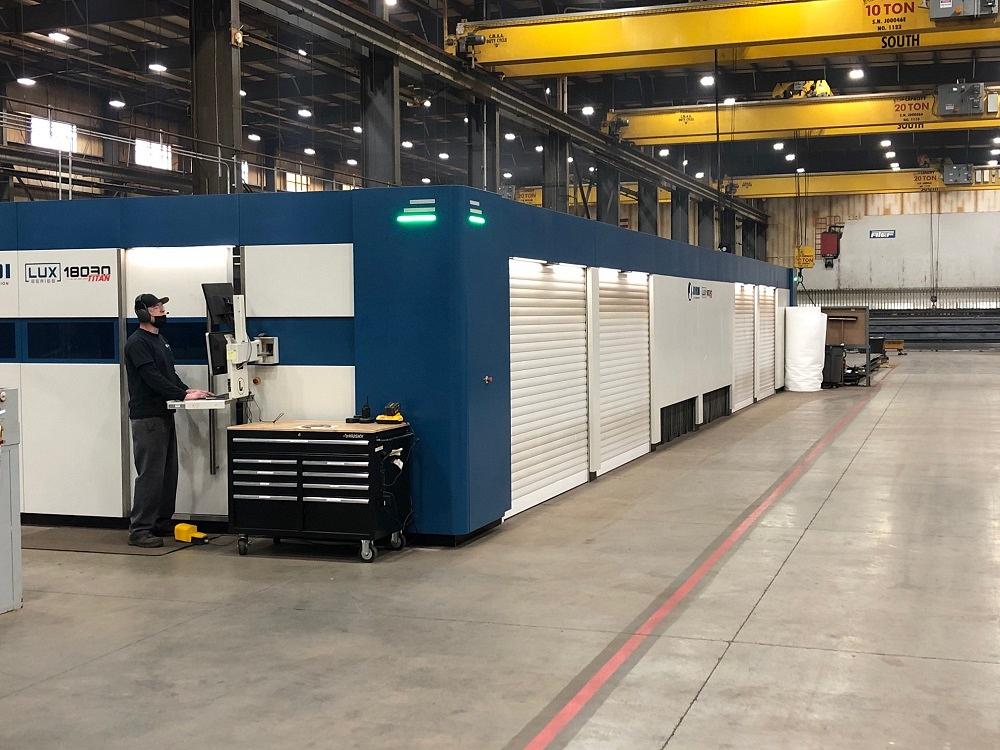- FMA
- The Fabricator
- FABTECH
- Canadian Metalworking
Categories
- Additive Manufacturing
- Aluminum Welding
- Arc Welding
- Assembly and Joining
- Automation and Robotics
- Bending and Forming
- Consumables
- Cutting and Weld Prep
- Electric Vehicles
- En Español
- Finishing
- Hydroforming
- Laser Cutting
- Laser Welding
- Machining
- Manufacturing Software
- Materials Handling
- Metals/Materials
- Oxyfuel Cutting
- Plasma Cutting
- Power Tools
- Punching and Other Holemaking
- Roll Forming
- Safety
- Sawing
- Shearing
- Shop Management
- Testing and Measuring
- Tube and Pipe Fabrication
- Tube and Pipe Production
- Waterjet Cutting
Industry Directory
Webcasts
Podcasts
FAB 40
Advertise
Subscribe
Account Login
Search
Metal fabricator's productivity increases up to 20% with wireless headsets
- August 25, 2021
- News Release
- Safety

An AT&F technician wears a Sena Industrial Mesh wireless headset to communicate with an operator at the other end of a 118-ft. fiber-optic laser table.
Situation
Cleveland-based AT&F produces high-quality metal fabrications for projects from submarines and armored vehicles to cranes and railcars. A focus on massive scale and size of equipment gives the fabricator exceptional manufacturing capabilities, but distance, noise, and hearing protection complicate conversations among team members in the production facilities.
For instance, on the company’s large 5-axis Jordi fiber-optic laser cutting system, one employee operates the machine at one end, and another removes finished parts at the other end and sets up metal plates for the next batch. This requires the two workers to coordinate and communicate frequently.
The challenge is that the machine is 118 ft. long and has a very loud air ventilation downdraft system. To communicate, one team member must walk the entire length of the machine to get close enough to talk, and both must still shout to be heard.
The company considered using two-way radios, but it is hard to hear a conversation over radio while wearing hearing protection. Also, radios use push-to-talk technology, so the team members would have to take their hands off their task every time they needed to talk.
Resolution
AT&F EHS Director Matt Ellis decided to test Mesh Intercom wireless technology from Sena Industrial, offering Tufftalk M wireless headsets to the fiber-optic laser system operators. The headsets communicate wirelessly and create their own network without needing Wi-Fi, cellular signals, or power. Each headset acts as a node on the network, boosting and repeating the signal to other headsets. In this way, the network can reach the large work area covered by the drivers, and it can include a virtually unlimited number of users.
As soon as the operators tried the wireless headsets, which offer hearing protection rated for up to 26-dB noise reduction, they noticed how it made their job easier.
“We found the headsets to be very beneficial; you can hear a lot better than with the walkie-talkie style radios,” said one AT&F technician.
Unlike radios, which use analog FM radio technology, the headsets offer high-definition digital sound and noise-canceling features. “I hear crystal-clear sound through the headset,” another employee said. “I’m not hearing the noise outside the headset as I would with a radio.”
Use of the headsets has helped improve productivity. “When I take a plate off the table, I see if a secondary operation or anything specific to the job rack needs to be done,” said the employee. “If the laser skipped a little bit, or there's a spot that I need to clean, then I can just tell the operator immediately. It keeps the flow going rather than stopping and walking back and forth.”
According to Ellis, the walking and conversation takes about three minutes each time. Doing that 10 to 30 times per shift adds up. On some shifts, the time saved is 90 minutes per shift, which is a 20% productivity improvement. “What’s more, we need to consider the charge per hour to run that machine, which is obviously a lot more than the cost of an hour of labor,” he said.
The headsets work well at that distance and farther. The technician said the two can talk easily when the other walks to the other side of the facility, 300 ft. away.
subscribe now

The Fabricator is North America's leading magazine for the metal forming and fabricating industry. The magazine delivers the news, technical articles, and case histories that enable fabricators to do their jobs more efficiently. The Fabricator has served the industry since 1970.
start your free subscription- Stay connected from anywhere

Easily access valuable industry resources now with full access to the digital edition of The Fabricator.

Easily access valuable industry resources now with full access to the digital edition of The Welder.

Easily access valuable industry resources now with full access to the digital edition of The Tube and Pipe Journal.
- Podcasting
- Podcast:
- The Fabricator Podcast
- Published:
- 04/16/2024
- Running Time:
- 63:29
In this episode of The Fabricator Podcast, Caleb Chamberlain, co-founder and CEO of OSH Cut, discusses his company’s...
- Trending Articles
AI, machine learning, and the future of metal fabrication

Employee ownership: The best way to ensure engagement

Steel industry reacts to Nucor’s new weekly published HRC price

Dynamic Metal blossoms with each passing year

Metal fabrication management: A guide for new supervisors

- Industry Events
16th Annual Safety Conference
- April 30 - May 1, 2024
- Elgin,
Pipe and Tube Conference
- May 21 - 22, 2024
- Omaha, NE
World-Class Roll Forming Workshop
- June 5 - 6, 2024
- Louisville, KY
Advanced Laser Application Workshop
- June 25 - 27, 2024
- Novi, MI

























